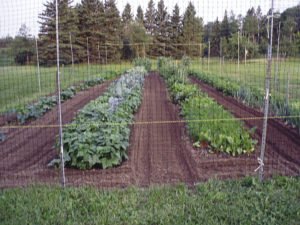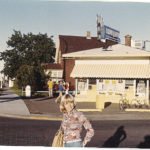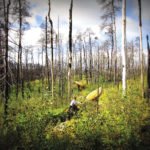In northern Minnesota, it often seems like winter dominates the year. As the flakes fall and snow accumulates, it’s hard sometimes to remember the soil under the frozen layers that is ready to help hopeful growers produce summer vegetables. Many gardeners in this corner of the world lament the short growing season and are forced to be very methodical to prepare themselves for the few months of sufficient sunlight and warmth. For these gardeners, the excitement of spring extends beyond the change in outdoor recreation opportunities; they are anxious to get their seeds in the soil and yearn to be tending to their crop.
Growing crops on the North Shore is a natural extension for many residents who appreciate the subsistence lifestyle. Gardeners from Duluth to Thunder Bay have a variety of plot arrangements, from small raised beds in the town of Grand Marais, to larger plots or greenhouses capable of producing quantities to freeze, can or dry.
Cook County resident and Master Gardener Diane Booth knows that being a successful gardener in the north can be tricky. She attributes her interest in gardening from growing up on her grandparents’ farm.
“My grandmother was a fabulous gardener and little did I know I was absorbing all those little tidbits she shared with us,” Booth said.
Armed with a background in biology and numerous classes to become a University of Minnesota Master Gardener, Minnesota Tree Inspector, Tree Care Advisor and Master Home Food Preserver, Booth is widely considered a go-to for gardening questions in the Cook County area, especially for beginner gardeners.

She has had success growing just about everything she has tried over the years, from sweet potatoes to melons. Her list also includes corn, tomatoes, winter squash, eggplant, popcorn and wheat, in addition to the staples like potatoes, beans, onions, cucumbers, peas, lettuce, broccoli and rutabagas.
Her set up includes a conventional system with two large spaces, each with a different climate. Having the two different spaces allows her to rotate crops and garden space with cover crops. She’s had these two spaces in operation for just about 30 years.
Her primary advice to beginner gardeners in the northland is to learn about the specific region in which they live—both through hands-on experience and books. The Cook County Extension group releases a recommended vegetable variety list every three years, as well as lists for large and small fruits, annual flowers, perennial flowers, trees and shrubs. This list includes suggested vegetable varieties for home growers in Minnesota, with a special distinction given to varieties that are more likely to grow in the northern segment of the state.
“Many of these recommendations have been made after either personally growing them or talking with reputable gardeners throughout the county,” she explains. “I would recommend beginner gardeners to come by the Extension office and talk with me about where they are located in Cook County. Because we have so many different microclimates, it is hard to recommend specific plantings unless I know their locations and what they want to grow.”
Despite many years of great harvests, Booth also has had efforts that have not gone the way she intended. Attempting to grow red rhubarb proved an unexpected challenge, but not unheard of in the world of experienced gardeners.
“Everyone in the county has beautiful rhubarb, even if they aren’t trying to grow it,” she explained. “I have tried three different plantings of red rhubarb in three different locations and they always end up with disease; it doesn’t matter if I apply straw mulch or remove any diseased leaves. When you talk to gardeners, sometimes there is one or two plants that no matter what they do, just seem to elude their efforts to grow.”
As with many who live in the middle of a town, the growing space for Amanda Weberg is limited. A transplant from the state of Virginia, her gardening skills didn’t transfer as well as she would have hoped during her first summer in Minnesota.
“That summer was cool, and the bed was in a pretty shaded location. I don’t think we harvested anything from that effort,” she said. “Our gardening experiences in Virginia clearly didn’t translate to our new location.”
After attending a class on container gardening at the Cook County Community Center in Grand Marais, Weberg and her partner built a small greenhouse and added some additional raised beds. They also invested in lighting and heat mats to start their own seeds.

Weberg has had success growing things like green beans, broccoli, leafy greens, beets and carrots in her raised beds. Her small greenhouse lends itself well to growing peppers and potatoes have come through in her straw set-up. It hasn’t all been a rose garden, however.
“Last summer we kept the tomatoes in the greenhouse, and they didn’t really like that. Too much heat or possibly not the ideal soil mixture had us battling blossom end rot all season,” she explained. “We also ran out of room in the raised beds and tried summer squash in containers; that was a complete flop.”
Like Booth, Weberg recommends that beginner gardeners combine wisdom from books, websites and classes with the knowledge of a local mentor to get the most out of the experience.
“Each year presents new challenges, so it’s always a learning experience,” she said. “We hope that someday we have the expertise to help others improve their gardening skills.”
The Master Gardening groups in Duluth, Grand Marais and Thunder Bay are active and ready to help beginner gardeners get the most out of the upcoming growing season. Events put on by the Thunder Bay group include workshops about thrifty gardening, information sessions on native bees and how to garden with them in mind, in addition to an early summer plant sale.
The Cook County plant enthusiasts meet once a month from January through October and are available to offer tips and advice during classes or tours. They are on-call to answer questions and many will take the time to give individual, one-on-one attention. For truly visual and hands-on learners, some of the volunteers will even make house calls to help with planting suggestions.
For hopefuls wanting to submit questions electronically, the Duluth News Tribune publishes “Ask a Master Gardener,” Q&A’s about anything from guides to starting seeds to tips for growing cilantro. The responses from the master gardeners are archived and can be viewed at any time.
News about plant sales, seminars and workshops is available through the Northern Gardener website. The site, which also includes information about garden clubs across the state, has a mission to help gardeners in plant hardy Zones 3, 4 and 5 and has options for membership benefits. Visit northerngardener.org for more information.




